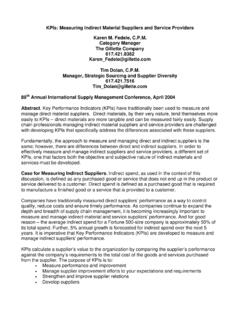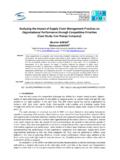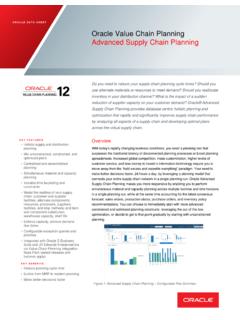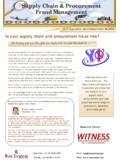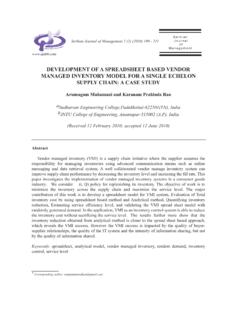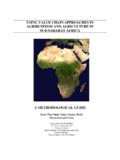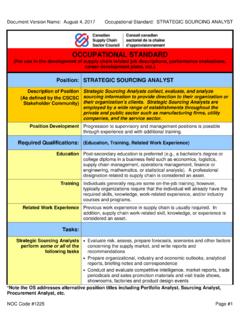Transcription of Managing the Chain of Custody: Minimizing Your …
1 Managing the Chain of custody : Minimizing your Risk and exposure ! William L. Michels, , CEO ADR North America, LLC 734/930-5070; 94th Annual International Supply Management Conference, May 2009 In the past year, we have experienced issues such as peanut butter contaminated with salmonella, adulterated milk, contaminated meat, toothpaste, dog food, toys and other products. These incidents have emphasized that 20th century processes and systems are out of sync with 21st century needs. When sourcing globally, our supply chains become complex with multiple stages and multiple border crossings. A burp or deviation in the Chain can have a disastrous impact and introduce considerable risk downstream in the supply Chain . Supply chains can reach 100 links, depending on the complexity of the product, local content laws, tax incentives, manufacturing capability and skill of the labor force. The most complex Chain I have personally encountered was a pharmaceutical product crossing six international borders with 64 different stages.
2 Chain of custody . Simply put, the Chain of custody is the unbroken path a product takes from the first stage in the supply Chain to the end customer, including raw commodity materials, conversion, transformation, distribution and logistics. Security. Anyone who has sourced products globally has probably outsourced the documentation process based on its extreme complexity. Logistics and shipments are a complete mystery to many companies. Once the shipment leaves its origin, it falls into a black hole until there is notification by a broker or customs that the shipment is clearing, or, if it is a food product, sampled by FDA. Are your containerized shipments secured? Are they subject to theft, counterfeiting, contamination, tampering, drug trafficking, contraband, or loss? The lack of a certification process combined with lack of visibility can introduce supply Chain risk. A company in the business products industry built several very complex progressive stamping dies in Asia with a 26-week lead time.
3 When the ship arrived, the container was not on the ship. The ensuing investigation revealed that the container had been cut loose and sent overboard in heavy seas. Chain of custody Requirements. The forest product industry, the logistics industry and others are developing standards for the Chain of custody process and creating certification processes and programs. This paper outlines current understanding of the requirements and criteria for a Chain of custody process. It should become painfully obvious that there needs to be a standard for Chain of custody certification and a certifying organization. A process is required that will develop a workable Chain of custody program. Step 1 Developing Key Control Points. After analyzing the manufacturing process it is necessary to develop key control points. Key control points are points where there is a combination of products. The key process control (KPC) points to where contamination or mixing of materials can occur.
4 In an ideal world all products would be fully tested and certified prior to manufacturing. However, the reality of any manufacturing operation suggests that these KPCs are points of vulnerability. Step-2 Product identification and uniform marking system. The simplest way to assure that there is no mixing of certified and uncertified materials is to create a marking and identification system that is fail-safe to even the simplest of operators. The marking system needs to be clear in every part of the process and include raw materials, work in process, finished goods, distribution and logistics to cover the entire supply Chain . A separation strategy for certified and uncertified materials would require different locations to segregate the materials. Step-3 Record keeping and document programs. The Chain of custody program will require detailed records and record systems to track all the activities of the product down to the lot, batch, minute and second of the manufacturing process.
5 The documentation process will keep track of all supply Chain activity from start to finish by lot, minute and second from the first producer through end consumer. Some heavily regulated industries such as the pharmaceutical and aerospace industries can lead the way, as they have these processes in place. It will not be surprising to see the Chain of custody process mandated to the food industry by the FDA, and eventually for it to be a requirement across all industries. Step 4 Assigning responsibility, authority and accountability (RAA) with assurance of compliance. Organizations will need to invest in people with the responsibility, authority and accountability for the design, implementation and monitoring of the Chain of custody process, certification, documentation and compliance. Compliance will be a key element to the process. Additional undertakings are developing the process, policies and procedures and training the internal organization. Step 5 Audit.
6 The Chain of custody process will require rigorous internal and external processes to drive compliance and assure product and process integrity. Many organizations are not currently equipped to audit the supply Chain inside and out. The audit is a key to the success of the program. Step 6 Supply Chain integration. Supply managers will also have the burden of developing a certification process for the downstream integration of the Chain of custody processes. Suppliers will require procedures, processes, compliance monitoring and education. This is quite an undertaking for any organization. We have been identifying the need for integration and management of the supply chains, which will be forced through the Chain of custody process. Conclusion. Continued product failures resulting in public safety concerns, along with terrorism, product tampering, failures from low cost country sources, process failures and concerns about the security of our logistics and distribution networks, have led to the Chain of custody process discussion.
7 Many consumer groups are calling for increased regulation and controls on all products. Some industries, including forest products, logistics and chemicals, have taken steps to create the Chain of custody process for their industries. Some are now marketing their certification process for other industries. If you or your organization hasn t yet thought much about this topic, it could be imposed on your agenda with regulation. Are you ready to implement a Chain of custody process? What is the cost of the program? Where will you find the resources? I believe it is essential for the supply management community to develop its own guidelines and standards for the Chain of custody before it is too late.






